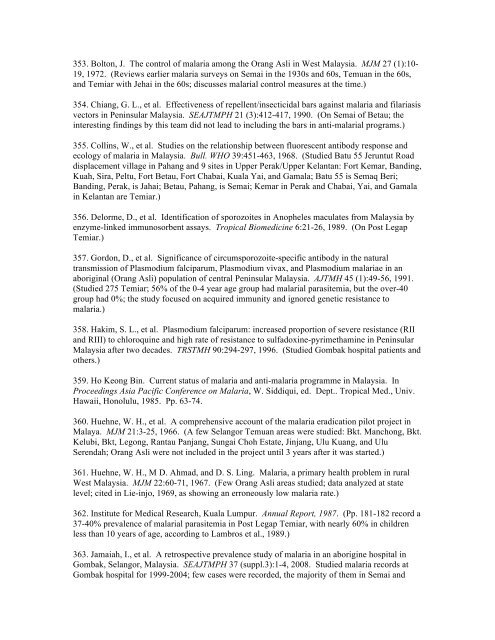Orang Asli (Indigenous Malaysian) Biomedical Bibliography AS Baer
Orang Asli (Indigenous Malaysian) Biomedical Bibliography AS Baer
Orang Asli (Indigenous Malaysian) Biomedical Bibliography AS Baer
You also want an ePaper? Increase the reach of your titles
YUMPU automatically turns print PDFs into web optimized ePapers that Google loves.
353. Bolton, J. The control of malaria among the <strong>Orang</strong> <strong>Asli</strong> in West Malaysia. MJM 27 (1):10-<br />
19, 1972. (Reviews earlier malaria surveys on Semai in the 1930s and 60s, Temuan in the 60s,<br />
and Temiar with Jehai in the 60s; discusses malarial control measures at the time.)<br />
354. Chiang, G. L., et al. Effectiveness of repellent/insecticidal bars against malaria and filariasis<br />
vectors in Peninsular Malaysia. SEAJTMPH 21 (3):412-417, 1990. (On Semai of Betau; the<br />
interesting findings by this team did not lead to including the bars in anti-malarial programs.)<br />
355. Collins, W., et al. Studies on the relationship between fluorescent antibody response and<br />
ecology of malaria in Malaysia. Bull. WHO 39:451-463, 1968. (Studied Batu 55 Jeruntut Road<br />
displacement village in Pahang and 9 sites in Upper Perak/Upper Kelantan: Fort Kemar, Banding,<br />
Kuah, Sira, Peltu, Fort Betau, Fort Chabai, Kuala Yai, and Gamala; Batu 55 is Semaq Beri;<br />
Banding, Perak, is Jahai; Betau, Pahang, is Semai; Kemar in Perak and Chabai, Yai, and Gamala<br />
in Kelantan are Temiar.)<br />
356. Delorme, D., et al. Identification of sporozoites in Anopheles maculates from Malaysia by<br />
enzyme-linked immunosorbent assays. Tropical Biomedicine 6:21-26, 1989. (On Post Legap<br />
Temiar.)<br />
357. Gordon, D., et al. Significance of circumsporozoite-specific antibody in the natural<br />
transmission of Plasmodium falciparum, Plasmodium vivax, and Plasmodium malariae in an<br />
aboriginal (<strong>Orang</strong> <strong>Asli</strong>) population of central Peninsular Malaysia. AJTMH 45 (1):49-56, 1991.<br />
(Studied 275 Temiar; 56% of the 0-4 year age group had malarial parasitemia, but the over-40<br />
group had 0%; the study focused on acquired immunity and ignored genetic resistance to<br />
malaria.)<br />
358. Hakim, S. L., et al. Plasmodium falciparum: increased proportion of severe resistance (RII<br />
and RIII) to chloroquine and high rate of resistance to sulfadoxine-pyrimethamine in Peninsular<br />
Malaysia after two decades. TRSTMH 90:294-297, 1996. (Studied Gombak hospital patients and<br />
others.)<br />
359. Ho Keong Bin. Current status of malaria and anti-malaria programme in Malaysia. In<br />
Proceedings Asia Pacific Conference on Malaria, W. Siddiqui, ed. Dept.. Tropical Med., Univ.<br />
Hawaii, Honolulu, 1985. Pp. 63-74.<br />
360. Huehne, W. H., et al. A comprehensive account of the malaria eradication pilot project in<br />
Malaya. MJM 21:3-25, 1966. (A few Selangor Temuan areas were studied: Bkt. Manchong, Bkt.<br />
Kelubi, Bkt, Legong, Rantau Panjang, Sungai Choh Estate, Jinjang, Ulu Kuang, and Ulu<br />
Serendah; <strong>Orang</strong> <strong>Asli</strong> were not included in the project until 3 years after it was started.)<br />
361. Huehne, W. H., M D. Ahmad, and D. S. Ling. Malaria, a primary health problem in rural<br />
West Malaysia. MJM 22:60-71, 1967. (Few <strong>Orang</strong> <strong>Asli</strong> areas studied; data analyzed at state<br />
level; cited in Lie-injo, 1969, as showing an erroneously low malaria rate.)<br />
362. Institute for Medical Research, Kuala Lumpur. Annual Report, 1987. (Pp. 181-182 record a<br />
37-40% prevalence of malarial parasitemia in Post Legap Temiar, with nearly 60% in children<br />
less than 10 years of age, according to Lambros et al., 1989.)<br />
363. Jamaiah, I., et al. A retrospective prevalence study of malaria in an aborigine hospital in<br />
Gombak, Selangor, Malaysia. SEAJTMPH 37 (suppl.3):1-4, 2008. Studied malaria records at<br />
Gombak hospital for 1999-2004; few cases were recorded, the majority of them in Semai and















